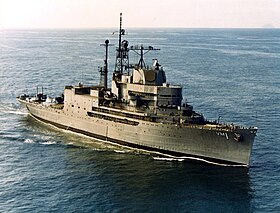USS Norton Sound (AVM-1)
 The Norton Sound at sea, around 1980 |
|
| Overview | |
|---|---|
| Keel laying | September 7, 1942 |
| Launch | November 28, 1943 |
| 1. Period of service |
|
| Commissioning | January 8, 1945 |
| Decommissioning | December 11, 1986 |
| Whereabouts | Broken down in 1989 |
| Technical specifications | |
| displacement |
14,000 tons |
| length |
164.72 meters |
| width |
21.11 meters |
| Draft |
6.78 meters |
| crew |
540 |
| drive |
2 propellers, driven by 4 steam turbines; 12,000 kW |
| speed |
18 knots |
| Armament |
Changing armament as a test ship |
The USS Norton Sound (AV-11 / AVM-1) was originally a Currituck-class unit that was commissioned in January 1945 as an aircraft mother ship . In 1948 she was converted into a test ship for guided missiles and tested a variety of new weapon systems in this function, which were later used successfully on warships of the United States Navy . From 1962 to 1964, Norton Sound was completely rebuilt for new weapon systems and then remained in active service until December 1986. In 1989 the ship was demolished.
history
Second World War
The Norton Sound was laid down on September 7, 1942 as a Currituck-class unit in the shipyard of the Los Angeles Shipbuilding & Dry Dock Company in San Pedro and was launched on November 28, 1943. The commissioning took place on January 8, 1945 under the command of Captain Ben Scott Custer.
After test drives in the Pacific, the Norton Sound was relocated to Pearl Harbor . From there she completed training missions and from April 1945 was an aircraft mother ship off Saipan . From May to June, the ship lay in front of the Kerama Islands and actively participated in the defense against Japanese air strikes. After the war ended, Norton Sound remained in Japan as part of the occupying power until October 1945 and was then stationed in China. The ship was awarded two Battle Stars for its services .
Post-war years and service as a test ship
After returning to the United States in April 1946, Norton Sound completed exercises on the American east coast. In 1948 the ship was converted into a test ship for guided missiles in the Philadelphia Naval Shipyard over a period of seven months. The renovation was finished in October 1948. From then on, the home port was Port Hueneme, California .
After tests with weather balloons , various new guided missiles were tested on board the Norton Sound . So in February 1949 Aerobee missiles were installed on the ship. In addition, tests with weather balloons continued to take place, including at the equator . After another reconstruction in San Francisco from February to March 1950, the Norton Sound was able to fire a five-ton Viking missile .
In the following years the ship was modernized and rebuilt again and again in order to be able to carry new guided missiles. During its service, Norton Sound tested RIM-2 Terrier and RIM-24 Tartar weapon systems before they were introduced on other United States Navy warships.
In August and September 1958, the Norton Sound was an important part of Operation Argus , during which it fired three launch vehicles with smaller atom bombs from its deck, which then detonated at an altitude of about 300 kilometers. This was not only the only nuclear test in the Atlantic, but also the first launch of a ballistic missile with nuclear explosives.
From November 1962 to spring 1964 the ship was rebuilt in Baltimore , which changed the exterior of the superstructure significantly. In addition to anti-aircraft missiles of the type RIM-50 Typhon LR , the Norton Sound received a new radar system of the type AN / SPG-59, which was placed on the navigating bridge. On June 20, 1964, the ship returned to service.
Tests for electronic countermeasures and gyroscopic instruments were carried out over the next few years . In 1973 the Norton Sound was the first ship of the United States Navy to receive the Aegis combat system , which, after successful tests on board, was used on all later cruisers and destroyers of the United States. Also in 1981 , the Norton Sound was the first ship to receive a vertical take-off system for missiles , which was later used on the units of the Ticonderoga class and the Arleigh Burke class .
After 41 years of service, the Norton Sound was retired on December 11, 1986 and deleted from the Naval Vessel Register on January 26, 1987 . The ship spent a long time in the reserve fleet before it was sold to Taiwan on October 20, 1988 . There it was demolished in 1989.
Web links
- Entry about the ship on navsource.org (English)
- Entry about the ship on history.navy.mil (English)
- Entry about the ship on vpnavy.net (English)
Individual evidence
- ^ Norton Sound. In: Naval History and Heritage Command. August 13, 2015, accessed May 27, 2019 .